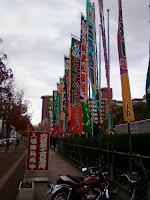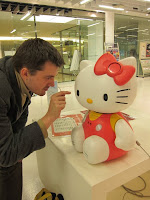Last week my watch broke. Isn’t my life so full of drama and excitement? So after searching on Google maps for a nearby watchmaker I left work a little early and headed there. What I didn’t know, however, was that the shop of Nagano Tokeiten was actually a time machine. It took me back to a magical land where sunglasses were circular, Zippo lighters were ubiquitous and everything and I mean everything was beige. Yes, I had arrived in the 1970s.
As I walked in the door, the owner span around in his chair, burping out a greeting. “Irashaimasssurrgh.” He got halfway through his first word before falling face first into a display cabinet of vintage cigarettes. The man was drunk, very drunk. There was half a bottle of whiskey on the counter and his ashtray was piled high with a veritable mountain of ash and butts and all this before 2pm. To be honest I was starting to doubt whether this man was even capable of replacing the battery in my watch without turning it into a piece of modern art.
Nevertheless, I pressed forwards with my request in the hope that he would call upon hidden reserves of sobriety and focus on fixing my watch. Things didn’t get off to a great start however, when he started dropping his screwdrivers on the floor. I took the time to look around the shop, although museum would probably be a better word. The fading posters on the wall advertising long discontinued brands of shampoo, the bizarre frameless glasses from the 1950s steadily accumulating dust and the antique radio with its guts spilling out on the counter all added to a strong other worldly scenario. The T.V. in the corner played the same advert over and over (ever since the Earthquake many advertisers have pulled their commercials from T.V. leading to a hellish nightmare scenario where the same two or three adverts are repeated ad nauseum) and the steady ticking of the clocks started becoming mesmerising.
It was then that I realised that the room was not heavy with cigarette smoke, but with sleeping gas. Too late I realised I’d walked into a trap. Gasping for breath I collapsed on the floor, the watchmaker’s grinning, leering face looming over me was the last thing I saw before I lost consciousness. I awoke strapped to a chair in the watchmaker’s basement. Despite struggling, I couldn’t manage to loosen my bonds. The watchmaker eventually came in accompanied by two men dressed in sharp suits and proceeded to repeatedly ask me whether ‘it was safe’. Unsure of how to reply I hesitated, lost in confusion and fear. Unsatisfied by my lack of reply he started drilling through one of my teeth with a dentist drill. Anyway to cut a long story short, it all ended up with me forcing him to eat his Nazi diamonds at gunpoint.
Now unless I’m confusing the end of this story with a film starring Dustin Hoffman and Lawrence Olivier, my trip to the watchmaker turned out to be more eventful than I expected.


























